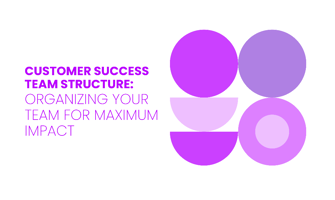Unreliable demand forecasts lead to lost sales, wasted inventory, and poor customer experience....
Why is Customer Success Important? Driving Growth and Retention
Imagine buying a toy and not knowing how to play with it. Customer success steps in to help you enjoy your purchase. For businesses, this means making sure customers are happy and use products well.
Focusing on customer goals and satisfaction helps companies keep clients longer. They can also sell more and grow. Customer success is not just about fixing problems. It is about building strong and helpful relationships that benefit everyone.
Understanding Customer Success
Success metrics for customer success include:
Customer lifetime value
Customer satisfaction rates
Customer success ensures clients achieve their goals with products and services.
Customer support addresses immediate issues or problems.
Customer success managers take proactive steps in the customer journey. They work on strategies to:
Enhance customer experiences
Reduce churn risk by monitoring customer health and interaction metrics
They ensure effective onboarding processes for new customers. This helps reduce churn and improve retention.
These managers look for opportunities to cross-sell and upsell solutions, contributing to greater revenue.
Customer success teams engage in ongoing relationships, aiming for renewal and sustained value.
Their efforts involve continuous feedback collection and the use of success metrics to drive client satisfaction and company growth.
Strategic actions in account management and customer relationship management help identify consumer needs, create tailored experiences, and foster long-term loyalty.
By closely tracking churn risks and adjusting strategies, customer success teams help maintain a healthy customer base and overall business success.
Why Is Customer Success Important?
Driving Growth and Retention
To drive growth and retention, a company can use customer success strategies.
Build strong relationships and help customers achieve their goals. This ensures satisfaction and loyalty.
An effective strategy includes:
Proactive onboarding
Tailored solutions
Continuous interactions with clients
Teams can track success metrics such as:
Customer lifetime value
Feedback
KPIs
These metrics measure the effectiveness of the efforts. They provide valuable insights into customer health and identify churn risk.
Align customer success with overall growth. Integrate customer success managers with sales and account management. This allows focus on reducing churn and improving customer retention.
Offer personalized customer experiences and proactive support. This increases revenue through cross-sell and upsell opportunities.
Focus on the customer journey, from onboarding to renewal, to maintain satisfaction and drive long-term success.
A digital-first approach enhances consumer interaction with products and services. It ensures a seamless and valuable customer experience.
Emphasize proactive account management and customer service. This improves retention and attracts new customers.
Nurture a customer-centric culture that supports growth.
Boosting Customer Experience
Customer success teams can use technology to improve the customer experience. They can use digital-first strategies and tools that automate the customer journey. These tools help track success metrics, identify client needs, and monitor customer health.
Personalized communication is important. It shows that the company values each customer’s unique goals. This means customer success managers should reach out proactively, especially during the onboarding process. The goal is to ensure customers get value from the products and services.
Gathering customer feedback is important for improving the customer experience. Regular feedback helps find areas that need improvement, like churn risk and retention challenges. Companies can use this data to adjust their strategies and improve products and customer support.
Effective communication, a solid onboarding process, and proactive relationship management can lead to:
Increased customer satisfaction
Reduced churn
Higher customer lifetime value
Cross-sell and upsell opportunities can also be found, leading to revenue growth. An account management approach ensures ongoing support and value for both new and existing customers throughout their entire lifecycle.
Improving Customer Onboarding
Streamlining the onboarding process can help new customers feel comfortable. Key steps should include:
Sending a welcome email.
Offering a walkthrough of products or services.
Regular check-ins from the customer success team.
Training and resources should be easy to find, like through video tutorials or webinars. A structured onboarding process helps set clear goals and success benchmarks. This proactive approach reduces churn risk and improves customer retention.
By providing timely support and personalized interaction, the customer success team can find upsell and cross-sell opportunities. This enhances customer lifetime value. Modern strategies ensure customers feel valued and understood, boosting overall satisfaction.
Tracking key indicators like customer health and feedback helps the team address issues promptly. This approach aids in renewals, encourages growth, and deepens relationships. Effective account management and regular interaction with a customer success manager support long-term success.
Enhancing Customer Feedback Loop
You can gather feedback using:
Regular surveys
Social media monitoring
Feedback forms
Direct interactions
The customer success team should use modern tools to analyze this feedback and track KPIs. Focus on customer retention and understanding success metrics. This helps identify churn risks and new opportunities.
The customer success manager and team work to make sure feedback leads to real changes in products and services. Inform customers about improvements based on their input through emails and customer portals. This makes the customer journey smoother, increases satisfaction, and boosts retention.
To close the loop effectively:
Have a proactive onboarding process
Maintain frequent touchpoints
Account managers and customer support teams should work together to offer timely solutions and build positive relationships. This reduces churn, improves customer experience, and drives growth, which is important for success in subscription and sales-driven models.
Another benefit of a strong feedback loop is increasing customer lifetime value through cross-sell and upsell opportunities.
Strategies for Effective Customer Success
Proactive Account Management
Customer success teams can stay ahead by keeping in regular touch with customers. They should understand their customers' goals and success measures.
Proactive account management is important. It helps track key performance indicators (KPIs) and customer health. This allows teams to spot churn risk early and offer timely solutions.
Getting regular feedback from customers helps improve the onboarding process and their overall experience. Using data analytics, managers can see customer behavior. This improves retention and lowers churn.
Data also helps find chances for cross-selling and upselling, which boosts revenue. Digital-first strategies and constant customer journey monitoring help account managers predict and meet needs efficiently.
Success strategies include:
Creating personalized customer journey maps.
Ensuring a strong onboarding process.
Keeping proactive communication to build long-term relationships.
Aligning customer support with success goals improves customer satisfaction, lifecycle value, and retention rates.
Implementing Best Practices
The team can incorporate industry standards into daily operations by regularly reviewing and updating their strategies and procedures. They can stay informed about the latest trends and tools in customer success. Customer success managers (CSMs) should focus on client goals and integrate feedback from customer interactions.
Important metrics to evaluate effectiveness include:
Customer retention rates
Customer satisfaction scores
Net Promoter Score (NPS)
Customer lifetime value
Tracking these KPIs helps understand customer health and churn risk. Continuous improvement is possible by establishing a feedback loop. Insights from customer experiences should be shared with the team to create solutions that enhance the customer journey. This leads to a more refined and proactive onboarding process.
Focusing on digital-first customer success, personalized support, and a strong customer success team can help reduce churn, increase revenue, and foster lasting relationships. Regular communication between customer support, account managers, and sales teams ensures a seamless customer experience. This also nurtures growth through cross-sell and upsell opportunities.
Impact on Revenue and Growth
Customer success strategies have greatly improved revenue growth. They build deeper customer relationships and increase customer retention.
Personalized customer interactions from a dedicated team lead to higher client satisfaction. This reduces the risk of losing customers. Teams track success metrics and KPIs to make sure customers meet their goals and find value.
Proactive onboarding and continuous support make customers more likely to renew subscriptions. They also tend to buy more products or services, including cross-sell and upsell opportunities.
Effective customer success efforts provide helpful feedback. This allows for tailored solutions and better customer experiences. As a result, there is a boost in customer lifetime value.
Companies see scalable revenue models through sustained growth and new customer acquisition. Improved customer health through dedicated management ensures ongoing support. This ultimately drives company revenue upward.
Role of Customer Success Teams
Customer Success Teams help keep customers by providing proactive support, tailored onboarding, and personalized experiences.
They focus on reducing churn risk by ensuring customers get value from products or services.
Their strategy includes tracking success metrics and KPIs to find cross-sell and upsell opportunities.
To drive customer engagement and satisfaction, they build strong relationships through regular interactions.
They understand customer goals and provide tailored solutions.
These teams use digital-first approaches to make customer journeys smooth and seamless.
They also work closely with sales and account management to share insights and feedback.
This helps improve services and products.
They support renewals by offering continued value and meeting client needs, which boosts customer lifetime value and company revenue.
By focusing on customer satisfaction, Customer Success Teams help drive growth and maintain a high level of customer experience throughout the lifecycle.
Increasing Customer Retention Rates
Exponential Growth through Customer Success
Using customer success strategies can help a business grow quickly. These strategies improve customer satisfaction and retention.
A customer success team should focus on engaging with customers proactively. Personalized interactions help customers achieve their goals and get more value from products or services.
Tracking customer retention, KPIs, customer lifetime value, customer churn, and customer health is important. This data can identify risks, allowing quick action. For example, a strong onboarding process and continuous support can improve retention rates. This can lead to more upsell and cross-sell opportunities.
Digital-first models focus on customer journeys and experiences, enhancing relationships. Good account management and customer service can ensure smooth renewals and highlight new solutions for clients.
Aligning feedback with a solid strategy helps meet customer needs and boosts revenue through customer support. Regular interaction and personalized onboarding can maintain customer satisfaction and drive growth in subscriptions and sales.
By following these steps, businesses can encourage customer loyalty and achieve quick growth.
Why Preventing Customer Churn Is Expensive
Preventing customer churn can be expensive. A customer success team needs many tools. These tools help track customer health, measure KPIs, and monitor customer journeys.
Here’s what they need:
Software for customer support
Personalized onboarding
Customer experience tracking
A successful strategy also means hiring skilled managers. They engage proactively with clients. These teams use success metrics and customer feedback. This helps create tailored solutions and improves customer satisfaction.
Investments to prevent churn can affect revenue. Good customer care leads to better retention. It also increases customer lifetime value and opens more cross-sell and upsell chances. Focusing on renewal strategies is costly but necessary. Often, resources for churn prevention are more than those for new customer acquisition. This is due to ongoing interactions and maintaining relationships over time.
Good onboarding processes help new customers see value quickly. Digital-first customer success means constant vigilance and proactive support. This move is from reactive service to full customer relationship management. These efforts are very important for subscription-based businesses. They help maintain client loyalty and support sustainable growth.
Customer Success in SaaS Companies
New Customers and Sustainable Growth
Attracting and keeping new customers for long-term growth needs a good customer success plan. The customer journey starts with effective onboarding. The customer success team ensures clients understand the value of products and services.
Proactive customer support is important. It shifts from reactive service to anticipating customer needs. Interaction helps build relationships and ensures customer satisfaction. By monitoring customer health and spotting churn risk, teams can act early. This reduces customer churn and improves retention.
To drive growth, use strategies like personalized experiences, regular feedback, and analyzing success metrics. Customer success managers need to make solutions that match customer goals for long-term success. Digital-first practices and strategic advice can boost retention and satisfaction.
Focusing on new customers helps grow the business. It expands the client base and increases revenue. Understanding the customer lifecycle and tailoring approaches to their needs builds deeper relationships. Cross-selling and upselling, combined with good account management and renewal processes, increase customer lifetime value. By prioritizing customer success, companies help their customers reach their goals. This leads to long-term growth and a successful business.
Collaboration between Customer Success and Customer Support Teams
Collaboration between Customer Success and Customer Support teams helps improve the overall customer experience.
Both teams should focus on customer retention and satisfaction. This ensures customers achieve their goals with the products or services.
Here’s how they can work together:
Hold regular meetings to discuss customer feedback and update the customer journey.
Share success metrics, like customer health scores and KPIs, to address issues early and reduce churn risk.
Customer Success teams use proactive strategies such as onboarding and personalized interactions. Customer Support provides reactive solutions to specific problems.
Together, they can:
Identify opportunities for cross-sell and upsell.
Ensure successful renewals.
Improve customer lifetime value.
Using shared strategies, these teams help clients stay satisfied. This increases revenue and reduces churn.
When both teams align their efforts, the company gains:
Increased customer loyalty.
Higher subscription renewals.
A more seamless customer experience.
This contributes to the business’s growth and success.
FAQ
Why is customer success important for driving growth?
Customer success is important for driving growth because satisfied customers are more likely to become repeat buyers, leading to increased revenue and referrals. By providing exceptional service and support, businesses can cultivate loyalty and long-term relationships with their customers, resulting in sustainable growth.
How does customer success contribute to retention?
Customer success contributes to retention by proactively addressing customer needs, providing guidance on product usage, and offering ongoing support. For example, personalized onboarding sessions and regular check-ins can help customers see value in the product and reduce churn rates.
What is the impact of customer success on overall business success?
Customer success is crucial for overall business success as it leads to higher customer retention rates, increased customer lifetime value, and positive word-of-mouth referrals. For example, by proactively addressing customer needs and providing value-added services, businesses can improve satisfaction and drive revenue growth.
How can customer success help improve customer satisfaction?
Customer success can improve customer satisfaction by proactively engaging with customers, providing personalized support, and ensuring they achieve their desired outcomes. For example, conducting regular check-ins, offering training sessions, and resolving issues promptly can enhance satisfaction levels.
What strategies can businesses implement to improve customer success?
Businesses can improve customer success by implementing strategies such as personalized communication, proactive customer outreach, and providing exceptional customer support. For example, sending personalized follow-up emails, offering product tutorials, and having a dedicated customer support team can all enhance the overall customer experience.




